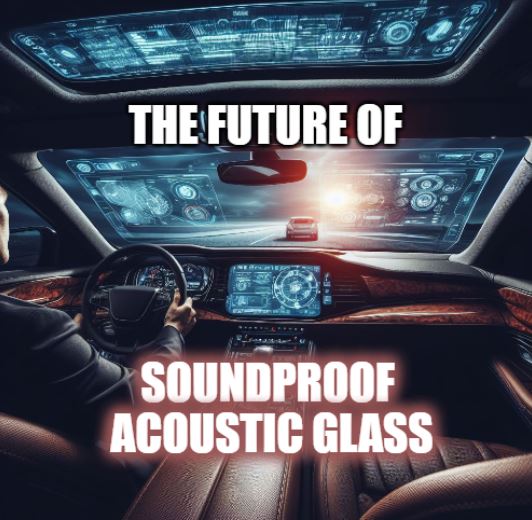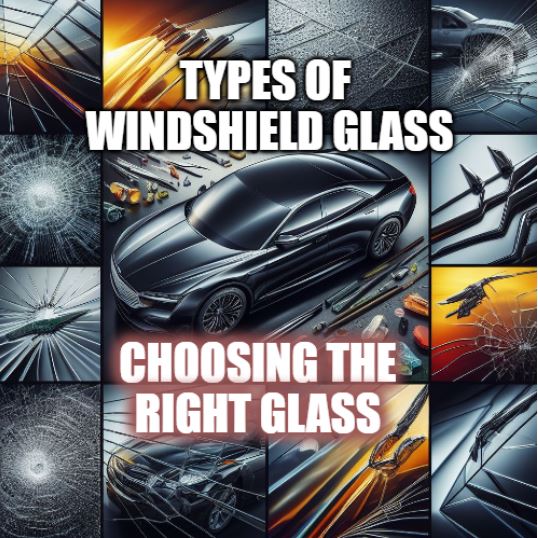Consumers have a wide array of options when it comes to choosing the right windshield glass for their vehicles. These options range from OEM and OEE glass for quality and safety to soundproof glass for noise reduction. Other choices include aftermarket glass for budget-conscious consumers, dealer glass for reliable performance, used or recycled glass for cost savings, and specialized types like tinted, heated, or solar control glass to enhance comfort.
Additionally, advanced options like self-dimming, laser-protective, and smart glass provide unique features. Selecting the appropriate windshield glass depends on individual preferences, safety requirements, budget considerations, and technology needs. Consulting with professionals is crucial for making an informed decision.
Consumers can choose from several types of windshield glass when it comes to windshield replacement or repair. The type of glass you select depends on your specific needs and preferences. Here are the most common types:
OEM (Original Equipment Manufacturer) Glass
OEM glass is designed and manufactured by the same company that produced the original windshield for your vehicle. It matches your car’s make and model precisely, ensuring an exact fit. It typically meets or exceeds the original specifications, making it a popular choice for those who want their replacement glass to be consistent with the vehicle’s design and safety standards.
Pros:
- Exact fit for your vehicle’s make and model.
- Meets or exceeds original safety and quality standards.
- Consistent with the vehicle’s design.
- Provides peace of mind regarding safety.
Cons:
- May be more expensive than some alternatives.
OEE (Original Equipment Equivalent) Glass
OEE glass is designed to meet the same safety and quality standards as OEM glass, providing a more affordable alternative. It is engineered to match the specifications of your vehicle’s original windshield, ensuring a proper fit and performance. OEE glass can be a cost-effective choice for consumers who want the assurance of quality and safety while being mindful of their budget.
Pros:
- Meets safety and quality standards like OEM glass.
- Cost-effective alternative to OEM glass.
- Proper fit and performance.
- Suitable for those on a budget.
Cons:
- Some variations in quality among OEE glass products.
Soundproof or Acoustic Glass

Soundproof or acoustic glass is designed to significantly reduce external noise, making your driving experience quieter and more peaceful. It consists of multiple layers of glass with an acoustic PVB (polyvinyl butyral) interlayer that dampens sound vibrations. This type of glass is especially beneficial for those who want to enjoy a quieter cabin environment and a more comfortable drive, regardless of external noise sources.
Pros:
- Significant reduction in external noise.
- Enhanced driving comfort and peace.
- Multi-layer construction with acoustic interlayer.
- Ideal for those seeking a quieter cabin.
Cons:
- Generally more expensive than standard glass.
- Heavier due to multiple layers.
Aftermarket Glass
Aftermarket glass is produced by companies other than the original equipment manufacturer. It may offer a more budget-friendly option, but it may not always meet the same quality and safety standards as OEM glass. Consumers should exercise caution when choosing aftermarket glass to ensure it meets their safety requirements.
Pros:
- Budget-friendly option.
- Widely available.
Cons:
- Quality can vary, and not all aftermarket glass meets safety standards.
- May not fit as precisely as OEM or OEE glass.
Dealer Glass
Dealer glass is sourced from the vehicle’s dealership or authorized service centers. It is often an OEM or equivalent glass, ensuring a high level of quality and compatibility with your vehicle. While it may be more expensive than other options, it provides peace of mind regarding fit and performance.
Pros:
- Typically matches OEM standards.
- Provides confidence in fit and performance.
- Reliable source from dealerships or authorized centers.
Cons:
- May come at a higher cost than other options.
Used or Salvaged Glass
Some consumers opt for used or salvaged glass, which is recycled from existing vehicles. While this can be a cost-effective choice, it comes with the risk of unknown wear and tear and may not provide the same level of performance or safety as new glass.
Pros:
- Economical choice for budget-conscious consumers.
Cons:
- Uncertain wear and tear history.
- May not provide the same level of safety as new glass.
Recycled Glass
Recycled glass is an eco-friendly option that uses materials from old windshields to create new ones. It can be a sustainable choice, but it may not always meet the same safety standards as OEM or new glass.
Pros:
- Environmentally friendly option.
- Reduces the environmental impact of manufacturing.
Cons:
- May not meet the same safety standards as OEM or new glass.
Tinted Glass
Tinted glass has a special coating that reduces glare from sunlight and provides additional UV protection. It can enhance driving comfort and protect your vehicle’s interior from sun damage.
Pros:
- Reduces glare from sunlight.
- Provides UV protection for the vehicle’s interior.
Cons:
- May not be legal in some regions if the tint level exceeds regulations.
Heated Glass
Heated windshields have built-in electrical heating elements that help de-ice or defog the glass, improving visibility in cold weather. This feature is especially useful in regions with harsh winters.
Pros:
- Effectively de-ices and defogs the windshield.
- Improved visibility in cold weather.
Cons:
- Adds cost to the vehicle.
- May consume additional power.
Solar Control Glass
Solar control or reflective glass has a coating that reflects sunlight, reducing heat buildup in your vehicle. It can help maintain a comfortable interior temperature and reduce the strain on your air conditioning system.
Pros:
- Reduces heat buildup in the vehicle.
- Maintains a comfortable interior temperature.
Cons:
- May be more complex and expensive to repair or replace.
Rain-Sensing Glass
Some windshields come with sensors that detect rain and automatically activate the wipers. This feature enhances visibility during rainy weather.
Pros:
- Reduces glare and reflections for better visibility.
Cons:
- May add cost to the vehicle.
Anti-Reflective Glass
Anti-reflective glass features a special coating that reduces glare and reflections, enhancing visibility, especially during nighttime driving.
Electrochromic Glass
Electrochromic glass can change its tint or opacity electronically. It is often used in sunroofs and some luxury vehicles’ windshields to adjust the level of sunlight and glare.
Infrared (IR) Reflective Glass
IR-reflective glass has a coating that blocks infrared radiation, reducing heat buildup in the vehicle and helping maintain a comfortable interior temperature.
Anti-Fog Glass
Anti-fog glass includes a coating that prevents condensation and fog from forming on the windshield, ensuring clear visibility in humid or cold conditions.
Ultraviolet (UV) Blocking Glass
UV-blocking glass is designed to block harmful ultraviolet rays from the sun, protecting the vehicle’s interior and its occupants from UV damage.
Privacy Tint Glass
Privacy tint glass features a darker tint to enhance privacy for the vehicle’s occupants. It can also help reduce heat and glare.
Curved Glass
Curved windshields are designed with a curvature that matches the vehicle’s design and aerodynamics. They can enhance the vehicle’s aesthetics and provide better visibility.
Polycarbonate Windshields
Polycarbonate windshields are lightweight and highly impact-resistant, making them suitable for some racing and off-road vehicles.
Rain-Repellent Glass
Rain-repellent glass is treated with a hydrophobic coating that causes rainwater to bead up and roll off the windshield, improving visibility during rainy conditions.
Color-Matched Glass
Some high-end vehicles offer color-matched glass, which complements the vehicle’s exterior color for a seamless and stylish look.
Self-Dimming Glass
Self-dimming glass, often used in rearview mirrors, can automatically adjust its tint in response to glare from headlights behind your vehicle, reducing eye strain and improving nighttime visibility.
Privacy Curtain Glass
Privacy curtain glass includes a motorized curtain or shade that can be drawn across the windshield for added privacy or to block direct sunlight.
Laser Protective Glass
Laser protective glass is designed to block or absorb laser light, often used in specialized vehicles, such as military or law enforcement vehicles, to protect occupants from laser attacks.
Energy-Efficient Glass
Energy-efficient glass is designed to reduce the transfer of heat and cold, helping to maintain a more comfortable interior temperature and reduce the workload on the vehicle’s heating or cooling systems.
Repairable Glass
Some specially designed glass types have the advantage of being easily repairable in the event of minor damage, saving on replacement costs.
Convertible or Retractable Glass
Convertible or retractable glass is used in convertible vehicles, allowing the driver to open or close the windshield to experience the open-air feeling.
Sapphire Glass
While rare in automobiles, sapphire glass is incredibly scratch-resistant and is used in high-end luxury and sports cars to protect against damage.
Polylactic Acid (PLA) Windshields
PLA windshields are an environmentally friendly option made from renewable materials. They may be used in eco-conscious or sustainable vehicle designs.
Smart Windshields
Smart windshields may feature integrated heads-up displays, augmented reality information, or other advanced technologies, enhancing the driver’s experience and safety.
Consumers have a multitude of windshield glass options, each tailored to specific needs and preferences. Whether prioritizing safety, cost-efficiency, noise reduction, or advanced features, there is a glass type to match. While OEM and OEE glass offer quality and precise fit, aftermarket and recycled glass provide budget-friendly choices. Specialty glass types cater to various preferences, from tinted glass for glare reduction to self-dimming and laser-protective options. Making an informed decision involves considering safety, cost, and individual requirements. Consulting with professionals ensures the right choice for a satisfying driving experience.
Whether you opt for OEM or aftermarket solutions, SLP Autoglass is here to provide you with a competitive quote for your vehicle’s glass requirements. Don’t hesitate to get in touch with us today!
